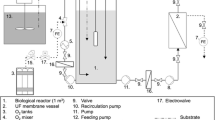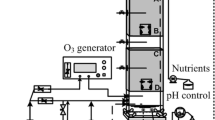Abstract
In the present study a biotrickling filter (BTF) with countercurrent gas/liquid flow packed with open-pore polyurethane foam — as a carrier of Thiobacillus thioparus (DSMZ5368) — was subjected to various starvation regimes such as non-contaminant loading, idleness, and complete shutdown. During the starvation periods specific oxygen uptake rates of microorganisms (SOUR) on packing were monitored. The BTF was subjected to non-contaminant loading (up to 16 h), cyclic non-contaminant loading (for 4 days) and gas shut-off (up to 24 h), and it recovered to its pre-starvation removal efficiency within a 2 ∼ 3 h period after resuming normal operating conditions. The recovery time values obtained during the runs in which these starvation regimes were imposed could be indirectly correlated with the corresponding SOUR values suggesting that the recovery time after such starvation regimes are dependent on the degree to which the aerobic biological activity has been reduced as a result of the imposed starvation regime. In the case of the complete shutdown of the BTF, the recovery time increased substantially after 1 and 2 days of complete shutdown, and after 5 days of complete shutdown the pre-starvation removal efficiency was not achieved even after 12 days of normal operation.
Similar content being viewed by others
References
Busca, G. and C. Pistarino (2003) Technologies for the abatement of sulphide compounds from gaseous streams: A comparative overview. J. Loss Prevent. Proc. 16: 363–371.
Shareefdeen, Z., B. Herner, and A. Singh (2005) Biotechnology for air pollution control — An overview. pp. 3–15. In: Z. Shareefdeen and A. Singh (eds.). Biotechnology for Odor and Air pollution control. Springer-Verlag Berlin Heidelberg. NY, USA.
Cox, H. H. J. and M. A. Deshusses (2002) Effect of starvation on the performance and re-acclimation of Biotrickling filters for air pollution control. Env. Sci. Technol. 36: 3069–3073.
Deshusses, M. A. (2005) Application of immobilized cells for air pollution control. pp. 507–526. In: V. Nedovic and R. Willaert (eds.). Applications of Cell Immobilization Biotechnology. Kluwer Academic Publisher, Netherlands.
Zhang, L., X. Meng, Y. Wang, and L. Liu (2009) Performance of biotrickling filters for hydrogen sulfide removal under starvation and shock loads conditions. J Zhejiang Univ. Sci. 10: 595–601.
Kim, K. S., W. J. Chung, and Y. S. Oh (2004) Dynamic behavior of compost Biofilters during periods of starvation and fluctuating hydrogen sulfide loadings. J. Environ. Sci. Heal. A. 39: 299–307.
Wani, A. H., R. M. R. Branion, and A. K. Lau (1998) Effects of periods of starvation and fluctuating hydrogen sulfide concentration on Biofilter dynamics and performance. J. Hazard. Mater. 60: 287–303.
Barona, A., A. Elias, R. Arias, I. Cano, and R. Gonzalez (2004) Biofilter response to gradual and sudden variations in operating conditions. Biochem. Eng. J. 22: 25–31.
Wani, A. H., R. M. R. Branion, and A. K. Lau (1998) Effects of periods of starvation and fluctuating hydrogen sulfide concentration on Biofilter dynamics and performance. J. Hazard. Mater. 60: 287–303.
Jiang, X. and J. H. Tay (2010) Microbial Community structures in a horizontal biotrickling filter degrading H2S and NH3. Bioresour. Technol. 101: 1635–1641.
Sercu, B., D. Nunez, H. V. Langenhove, G. Aroca, and W. Verstraete (2005) Operational and microbiological aspects of a bio augmented two-stage biotrickling filter removing hydrogen sulfide and dimethyl sulfide. Biotechnol. Bioeng. 90: 259–269.
Gabriel, D., J. M. Strauss, B. A. Sheridan, J. Brown, E. Torres, and M. A. Deshusses (2004) Performance assessment of biotrickling filters treating odors at Orange County sanitation district. Proceedings of 2004 Conference on biofiltration for air pollution control. October 19–22. USC, Redondo Beach, California, USA.
Duan, H., L. C. C. Koe, and R. Yan (2005) Treatment of H2S using a horizontal biotrickling filter based on biological activated carbon: Reactor setup and performance evaluation. Appl. Microbiol. Biotechnol. 67: 143–149.
Abdehagh, N., M. T. Namini, S. M. Heydarian, B. Bonakdarpour, and D. Zare (2011) Removal of H2S from synthetic waste gas streams using a biotrickling filter with polyurethane foam as synthetic bed. Iran. J. Environ. Health. Sci. Eng. 8: 245–254.
Namini, M. T., S. M. Heydarian, B. Bonakdarpour, and A. Farjah, (2008) Removal of H2S from synthetic gas streams using a biotrickling filter. IAChE. 5: 40–51.
Kim, S. and M. A. Deshusses (2003) Development and experimental validation of a conceptual model for biotrickling filtration of H2S. Env. Prog. 22: 119–128.
Hekmat, D., A. Linn, M. Stephan, and D. Vortmeyer (1997) Biodegradation dynamics of aromatic compounds from waste air in a trickle-bed reactor. Appl. Microbiol. Biotechnol., 48: 322–328.
Lee, E. Y., N. Y. Lee, K. S. Cho, and H. W. Ryu (2006) Removal of hydrogen sulfide by sulfate-resistant Acidithhiobacillus thiooxidans AZ11. J. Biosci. Bioeng. 101: 309–314.
Li, G., Z. He, T. An, X. Zeng, G. Sheng, and J. Fu (2008) Comparative study of the elimination of toluene vapors in twin biotrickling filters using two microorganisms Bacillus cereus S1 and S2. J. Chem. Technol. Biotechnol. 83: 1019–1026.
Chung, Y. C., Y. Y. Lin, and C. P. Tseng (2004) Operational characteristics of effective removal of H2S and NH3 waste gases by activated carbon biofilter. J. Air & Waste Manage. Assoc. 54: 450–458.
Koe, L. C. C. and F. Yang (2000) A bioscrubber for hydrogen sulfide removal. Water Sci. Technol. 41: 141–145.
Zhang, L. H., X. L. Meng, Y. Wang, and L. D. Liu (2009) Performance of biotrickling filters for hydrogen sulfide removal under starvation and shock loads conditions. J. Zhejiang Univ. Sci. B. 10: 595–601.
Moe, W. M. and R. L. Irvine (2000) Polyurethane foam medium for biofiltration. I: Characterization. J. Environ. Eng. ASCE. 126: 815–825.
Moe, W. M. and R. L. Irvine (2000) Polyurethane foam medium for biofiltration. II: Operation and performance. J. Environ. Eng. ASCE. 126: 826–832.
Mpanias, C. J. and B. C. Baltzis (1998) Biocatalytic removal of mono-chlorobenzene vapor in trickling filters. Catal. Today 40: 113–120.
Cox, H. H. J. and M. A. Deshusses (1999) Biomass control in waste air biotrickling filters by protozoan predation. Biotechnol. Bioeng. 62: 216–224.
Author information
Authors and Affiliations
Corresponding author
Rights and permissions
About this article
Cite this article
Namini, M.T., Abdehagh, N., Heydarian, S.M. et al. Hydrogen sulfide removal performance of a bio-trickling filter employing Thiobacillus thiparus immobilized on polyurethane foam under various starvation regimes. Biotechnol Bioproc E 17, 1278–1283 (2012). https://doi.org/10.1007/s12257-012-0035-0
Received:
Revised:
Accepted:
Published:
Issue Date:
DOI: https://doi.org/10.1007/s12257-012-0035-0




